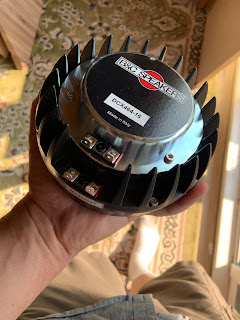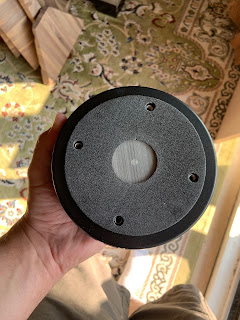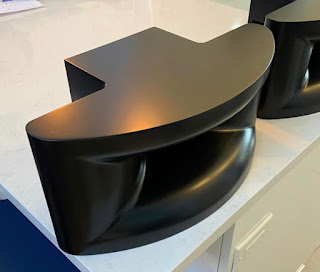This blog post features the new B&C DCX-464-16 1.4" Coaxial Compression Driver. I will show some objective test data and provide feedback on my subjective listening impressions. For this test I've used the ES-600 Biradial (First prototype) which has a 1.4" diameter throat.
This compression driver is compatible with the following horns...
ES-600 Biradial
ES-290 Biradial
Introduction
Information on this new driver can be found here.
These drivers came directly form B&C for my own evaluation. The drivers have some heft to them and are larger than I expected based on the photos.
Product Segment
The DCX-464 is intended for pro sound applications however there is keen interest on using this driver for hifi applications. This will be the context of this blog post and to that end I've decided to mount the driver to my ES-600 Biradial horn. This will give the driver it's best chance of providing hifi sound quality.
Objective Test Data
Frequency Response
Below is the frequency response of the DCX-464 with ES-600 Biradial. As expected this configuration provides solid extension down to 600Hz. The upper midrange has a falling response starting at 2.5kHz and is down -5dB by 4kHz. This region is where I opted to place my MF/HF crossover point. The peak at 5.3kHz is a resonance which will need to be dealt with in some manner if using for hifi.
 |
| DCX-464 with ES-600 Biradial Frequency Response (Midrange Only) |
Burst Decay
Below is the burst decay result for the midrange section. The region from 400Hz-5kHz is actually a very respectable result. Please not I'm showing the noise floor down -35dB which is a little more revealing than a standard burst decay. Also note the high Q resonance at 5.3kHz which is normally outside the passband once integrated into a finished crossover.
 |
| DCX-464 with ES-600 Biradial Midrange Burst Decay |
Step Response
Below is the step response for the midrange portion. The step response is as good as the TAD TD-2001 with a well behaved settle time of only 1.5ms. Considering that this driver is capable of 300Hz this is quite a commendable result.
 |
| DCX-464 with ES-600 Biradial Midrange Step Response |
High Frequency Portion
Below is the frequency response of the treble portion of the driver. Judging by the flat response from 6kHz - 17kHz this driver is free from any breakup modes. A good sign! There is a 2-3dB drop in the region from 3kHz-5kHz which didn't seem to be a problem during crossover development.
 |
| DCX-464 with ES-600 Biradial High Frequency Response |
Burst Decay
The burst decay for the high frequency does show some broad spectrum low Q resonances that seem to start after the initial impulse. This leads me to suspect that these are acoustical reflections inside the driver itself and not a mechanical resonance. There was nothing in my subjective listening tests that would indicate a problem. Perhaps some strategically placed open cell foam inside the driver (phase plug?) may fully alleviate this issue for added peace of mind.
 |
| DCX-464 with ES-600 Biradial High Frequency Burst Decay |
Step Response
The HF step response shows and extremely fast settle time of only 0.667ms. For comparison the DE-360 ring radiator compression driver had an unsually long step response of 3ms. The small format B&C DE120 has a 1.5ms step response. So this is a pleasant surprise to see.
 |
| DCX-464 with ES-600 Biradial High Frequency Step Response |
Crossover Development
Crossover development was a complete breeze to get something reasonable flat that sounded great. Each time I optimized the crossover further I was rewarded with better sound, however I did not spend a large amount of time on this. Below is the system frequency response I was able to achieve in short time.
 |
| DCX-464 with ES-600 Biradial Passive Crossover System Frequency Response |
System Step Response
Below is the step response of the finished crossover. The physical time alignment of the MF and HF are readily apparent. This would be considered a 'textbook' step response. (Very Good!)
 |
| DCX-464 with ES-600 Biradial Passive Crossover System Step Response |
Distortion Data
Below is the distortion sweep for both the MF and HF combined. Distortion is very low.
 |
| DCX-464 with ES-600 Biradial Distortion Sweep |
Subjective Listening Impressions
Below is my ranking for subjective listening impressions for hifi music applications.
Soundstage Depth --- 9/10
Soundstage Width --- 8/10
Smoothness --- 9/10
Coherence between midrange and treble --- 10/10
Coherence between mid-bass and midrange --- 10/10
Vocal Clarity Male --- 8/10
Vocal Clarity Female --- 10/10
Accurate Musical Instrument timbre --- 9/10
Sense of Dynamic Range: --- 10/10
Conclusion
The B&C DCX464 meets the performance target for hifi audiophile applications.
I often get inquires regarding a choice of compression driver for my horn products. It's been a struggle to suggest anything until now. Please let me summarize my rationale here.
- The B&C DCX464 is a new product and readily available.(There are risks involved in buying any used compression drivers)
- Provides excellent bandwidth from 300Hz-17kHz depending on the horn
- Zero breakup in the upper treble which is always the issue with medium or large format compression drivers.
- Easy and simple crossover development
- Easy load (16 ohm version)
- High Sensitivity
- High Power Handling (Low distortion at high SPL)
- 1.4" throat provides wider off-axis coverage in the upper treble than a 2" throat.



